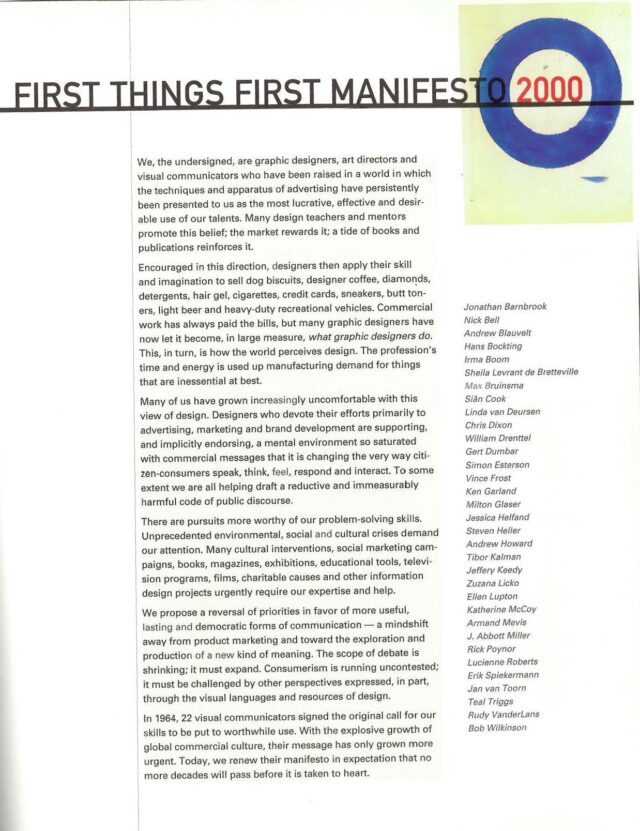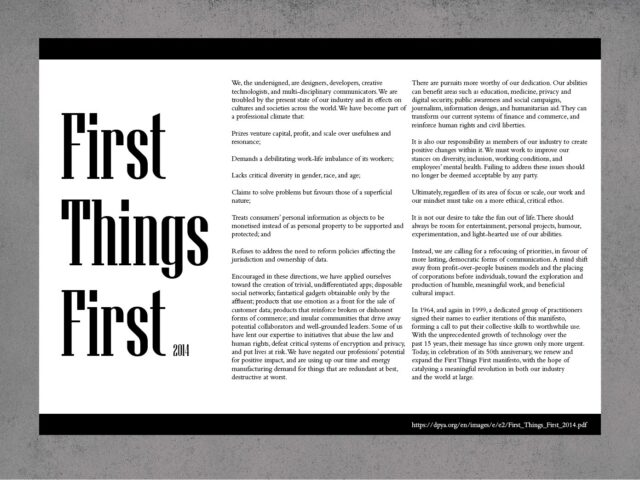First Things First Manifestos: 1964, 2000, 2014
By Krishnamurti Suparka
In 1964 British designer Ken Garland published a manifesto entitled First Things First. Alongside 20 other creative workers – design professionals and students – the manifesto was a response against the mechanisms of mainstream advertising at the time, which they saw as becoming too trivial in its fast-paced and time-consuming demands. It was a rally for designers to reconsider their positions and roles where consumer culture was on the rise. The alternative they seek is an ethical form of design that puts forward humanistic values, focusing on the improvement of society as a whole.
The first manifesto was published in its entirety by The Guardian, reaching a wide audience and inspired a generation of individuals with similar concerns to correspond via their respective fields of expertise. In the decades that follow, the manifesto helped sustain a line of thinking that sees design and designers as being more than just instruments of marketing and monetizing of goods.
In 2000 the manifesto was updated by a collective called Adbusters. Founded by Kalle Lasn and Bill Schmalz, Adbusters is a global network of artists/designers/writers/philosophers whose function is ‘to shake up complacent consumerist culture’ via design activism and media strategies.
As it is written on the updated version: “Many of us have grown increasingly uncomfortable with [how the profession’s time and energy is used up manufacturing demand for things that are inessential at best]. Designers who devote their efforts primarily to advertising, marketing and brand development are supporting, and implicitly endorsing, a mental environment…that is changing the very way citizen-consumers speak, think, feel, respond and interact. [W]e are all helping draft a…harmful code of public discourse.”
“There are pursuits more worthy of our problem-solving skills. Unprecedented environmental, social and cultural crises demand our attention. […] We propose a reversal of priorities in favour of more useful, lasting and democratic forms of communication ¾ a mindshift away from product marketing and toward the exploration and production of a new kind of meaning. […] Consumerism is running uncontested; it must be challenged by other perspectives expressed, in part, through the visual languages and resources of design.”
In the 14 years that passed since the 2000 version, the world has changed at an unprecedented rate. Global issues of poverty, inequality, refugee crisis resulting from the so-called war on terror, and climate change are some of the major issues we face on a regular basis. Within the creative field, developments in technology and communications paved way to a worldwide proliferation of popular culture. This has allowed aspects of the visual and related artistic/creative outputs to be produced and consumed at a rapid velocity on a global scale.
The 2014 manifesto was consequential in its apparent haste compared to the time gap between the first two. It was reflective and receptive to the pace of its era. As we enter the period where Creative Industry and Creative Economy is the norm, the urgency of advocating First Things First in its renewed understanding is as prevalent as ever. It highlights the importance of, as initiator Cole Peters mentioned, “[seeking] out meaningful, human-centered uses for our abilities as creative professionals, and to put people and ethics before profit and corporations.”
///
References:
http://www.designishistory.com/1960/first-things-first/
http://www.eyemagazine.com/feature/article/first-things-first-manifesto-2000
https://www.emigre.com/Essays/Magazine/FirstThingsFirstRevisited
https://dpya.org/wiki/images/e/e2/First_Things_First_2014.pdf
///
First Things First 1964:

First Things First 2000:

First Things First 2014:



Comments :